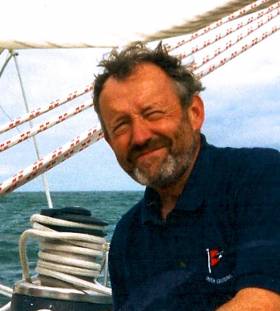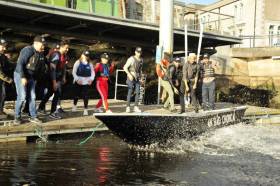Displaying items by tag: Donal Lynch
Donal Lynch 1937-2018
Donal Lynch’s remarkable life was a series of successful and interconnecting phases writes W M Nixon. His engaging presence is now gone from among us at the age of 81, and he is very much missed. Yet so much of what he was actively involved with – whether they were his visionary projects, ground-breaking initiatives, or popular events – have now become such an integral part of the fabric of our local and national life that he will always be with us. He leaves us with an abiding sense of continuity which lives on, its vitality imbued with his strong personal and family commitment, and his readiness for productive voluntary work.
He was born in 1937 in Clondrohid four miles northwest of Macroom, deep in a remote part of County Cork midway between Cork city and Killarney, where the nearest waterways were the hidden upper reaches of the River Lee. The only boy in a happy family of doting aunts, admiring sisters and proud parents, his introduction to the outside world came abruptly at age 12, sent away to school with places gained at Rochestown and then Rockwell College.
By comparison with the homely bliss of Clondrohid, school was “five cold, wet and hungry years” as he later put it, albeit with a look of faint amusement. Yet he was the very model of a good schoolboy, notably successful academically, and excelling in his first sporting love of athletics. That was halted by cruciate ligament damage, but he turned to rugby with even more attainment, scoring the try that won Rockwell the Senior Schoolboys Cup in Musgrave Park in 1954.
Rugby remained his main passion while studying engineering at University College Cork - he was to be a keen Munster fan all his life. But he had discovered his professional vocation in engineering – his analytical mind and insatiable hunger for knowledge allied to his satisfaction in finding practical solutions to complex building challenges came together to produce a gifted consultant constructional engineer when he graduated in 1958.
The Irish economy of the late 1950s was a sleepy backwater by comparison with today’s hectic pace, so he spent three years honing his consulting and practical skills in the UK, and returned – now married to Sheila O’Sullivan - to a position in consulting engineering in Dublin, where the building industry was on the move in the Lemass years.
In this busy time, he enjoyed working with architects and others in the construction industry, his taste for extensive background research allied to his broadening range of skill sets gaining a rising reputation in major new works and significant conservation projects.
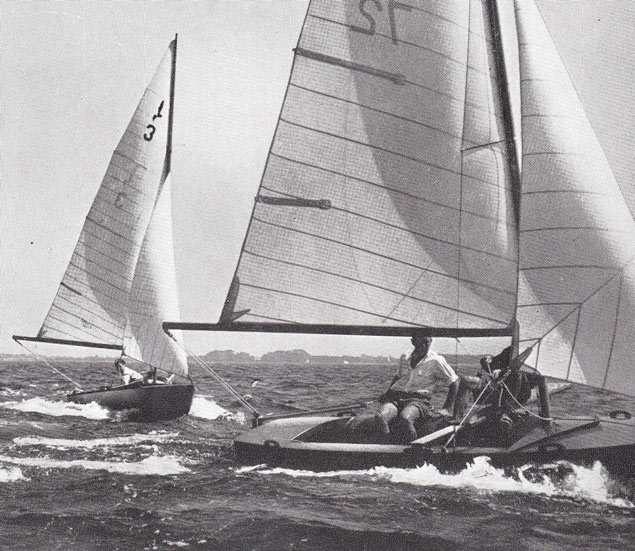 “It would be difficult to envisage a less suitable starter boat”. The 16ft Hornets needed special skills, as they used a sliding seat to give the crew extra hiking power, yet it was in one of these in Dublin Bay that the young Donal Lynch had his first real experience of sailing – and he liked it.
“It would be difficult to envisage a less suitable starter boat”. The 16ft Hornets needed special skills, as they used a sliding seat to give the crew extra hiking power, yet it was in one of these in Dublin Bay that the young Donal Lynch had his first real experience of sailing – and he liked it.
Ironically for a Corkman, it was in Dublin Bay that he really began to get involved with sailing, meeting up with fellow exile Ray Lovett who signed him up to crew on a Hornet complete with sliding seat, one of the relics of a small class which used to race at Kilbarrack Sailing Club.
It would be difficult to envisage a less suitable starter boat for your first proper introduction to sailing. Yet young Donal Lynch was hooked, and when he and Sheila and their increasing family returned finally to live in Cork in 1969 when he’d secured a placing with O’Connell & Harley, sailing was soon among his leisure interests, and he went afloat with Jim Fitzgibbon in Monkstown, first in a National 18, and then in an Enterprise, though for some years his primary participant sport was golf.
But work and family came first, and in 1972 he took a decisive career move in establishing the practice of Horgan Lynch with Michael Horgan, a notably prestigious consultancy which the two partners ran from offices in Cork and Dublin until their retirement thirty-one years later in 2003.
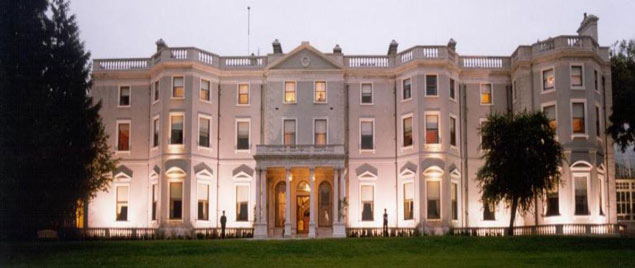 The major project to conserve Farmleigh was one of Horgan Lynch’s larger contracts
The major project to conserve Farmleigh was one of Horgan Lynch’s larger contracts
They were extremely fulfilling years with deep input into projects as various as the new Irish Life Centre in Dublin’s Abbey Street (where one of Donal Lynch’s special interests was the installation of Oisin Kelly’s Chariot of Life statue), and major conservations such as the nationally-owned Farmleigh House in the Phoenix Park, and Castle Hyde on the banks of the Blackwater near Fermoy. The company was also to be involved in modern projects such as the Glucksman Gallery in Cork and the Lyric Theatre in Belfast.
Successful projects at this standard were rewarding at every level, but equally the work rate was demanding, so in the mid-1970s Donal and Sheila bought The Pink House as a more relaxed second home at Glandore Harbour, a place which was to play an increasingly important role in their family life thereafter.
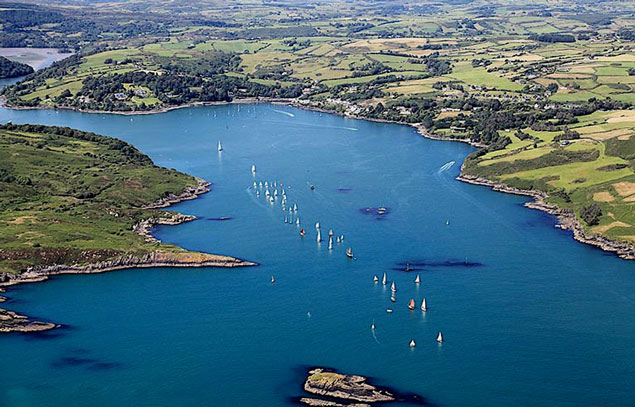 The haven from a hectic world and a busy career – Glandore was a special place for the Lynch family
The haven from a hectic world and a busy career – Glandore was a special place for the Lynch family
By this time Donal’s professional career was taking on a national and international dimension, as he rose to become President of the Association of Consulting Engineers and a member of the European Federation of Consulting Engineers Task Force for EU Directives.
At a personal level, his golfing interest reached a peak by winning the Captain’s Prize at Muskerry Golf Club in 1980, by which time The Pink House had become very much part of the Lynch family to underline a shift in emphasis – boats and sailing, having been just one of his leisure interests, now became central to his recreational way of life.
He was refreshingly varied in the boats he owned and sailed. The first was a little wooden-built cruiser, Felicidad. But as he was in the midst of developing the Horgan Lynch partnership, free time was precious, so he and Sheila soon moved on to the minimal-maintenance van de Stadt-designed glassfibre Pandora 22 Aurora, which for many years was at the core of their family sailing life in Cork Harbour and Glandore with their four daughters Therese, Frances, Eileen and Louise, not forgetting the family pooch Archie, whose affinity for the waters of Glandore Harbour was such that he had to be fished out many times.
 Summer sailing on Aurora - Donal, Sheila and Archie the dog, who liked Glandore Harbour so much he frequently had to be hauled out of it.
Summer sailing on Aurora - Donal, Sheila and Archie the dog, who liked Glandore Harbour so much he frequently had to be hauled out of it.
In Glandore, a close sailing friend was Cyril Kilgrew with the 29ft Westerly Konsort Greenfly which he and Donal cruised together, beginning with ventures to the Isles of Scilly and Cornwall, and in subsequent years broadening their horizons to Spain and the Canaries. Meanwhile, when in Glandore the two shipmates shared and promoted the idea that the growing local fleet required a local sailing club.
There’d been annual regattas of a sort since at least 1850, but Glandore being essentially a summer place with a small year-round population, setting up a proper club with a genuine local base interacting with the summer residents was something of a challenge. But it was the kind of challenge which suited Donal Lynch’s quietly thorough and determined yet low key approach, and in 1985 Glandore Harbour Yacht Club came into being with Donal Lynch as the first Commodore.
It was a role he was to fill twice, as he undertook it again in 2004-2005, while his shipmate and co-founder Cyril Kilgrew also did his two tours of duty - in 1989-1990 and 1998-1999 – and Donal’s son-in-law Cormac O’Carroll was likewise a double-duty volunteer, serving as Commodore in 2000-2001 and 2010-2011.
The debut of Donal Lynch on the sailing club administration scene in 1985 soon spread the news that in Glandore they’d a man who could quietly administer fresh initiatives in an effective way which didn’t upset long-established sailing community sensitivities in a broader area which included the world’s oldest yacht club in the Royal Cork at Crosshaven. So in due course, he found himself elected as Chairman of the Irish Sailing Association Southern Branch, and in turn, went on to serve on the ISA Board.
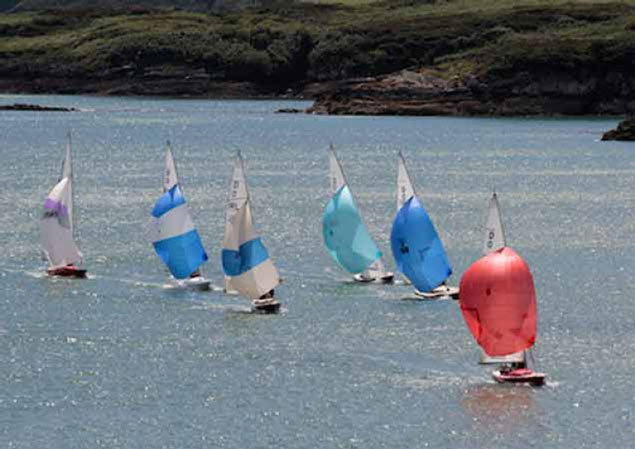 The Dragon Class at Glandore. Donal Lynch was a keen owner and participant in the classic section. Photo: Kathleen Hayes
The Dragon Class at Glandore. Donal Lynch was a keen owner and participant in the classic section. Photo: Kathleen Hayes
But despite having a national role, the development of Glandore sailing was one of his main concerns, and his personal boat choices reflected this, for although he spent a season or two with John Dory, a double-ended Peter Bruno design based on a Danish spaekhygger which revealed his growing interest in traditional craft, at various stages he owned no less than three International Dragons of various vintages – Aletta, Melisande and Pan – in support of the renowned fleet of Dragon classics at his home port, and in his latter days he was one of those who found the Squib keelboat to be ideal for Glandore needs.
But while all this was going on in relation to the contemporary sailing scene in Glandore, his increasing involvement with West Cork maritime life saw a growing fascination with the traditional boats of the area, a sometimes all-absorbing interest which led to research trips to remote little harbours where the last remains of the last boat of a special local type might be found and recorded.
In time, this was to develop into an all-encompassing interest in every Irish traditional boat type and in classic yachts too, and in the early 1990s, these strands in Donal Lynch’s extraordinarily busy life came together with the idea for the Glandore Classic Boat Regatta. Officially, it was being run as a means of building up a capital fund to acquire a clubhouse for GHYC. But after an initial launch with Donal as Chairman in 1992, when it finally burst fully-formed on the sailing scene in July 1994, it was clearly an idea whose time had come, allied as it was with the Summer School where Donal Lynch was able to reinforce his links to like-minded enthusiasts such as Hal Sisk of Dun Laoghaire – already a yachting historian of international repute – and Gary MacMahon of Limerick, whose longtime interest in the traditional boats of the Shannon Estuary such as the gandelows was now developing in additional directions with a growing interest in the voyaging achievements of Conor O’Brien of Foynes with the Baltimore-built 42ft Saoirse and 56ft Ilen.
 Typical mixed bunch at Glandore Classic Boat Regatta sailing past “The Terrace” – three Shannon One Designs with a Heir Island yawl and a modern classic, the Nigel Irens-designed Romilly Class
Typical mixed bunch at Glandore Classic Boat Regatta sailing past “The Terrace” – three Shannon One Designs with a Heir Island yawl and a modern classic, the Nigel Irens-designed Romilly Class
When we consider that the eclectic collection of boats present at that first complete Glandore Classics Regatta and Summer School in 1994 included the Sparkman & Stephens 54ft yawl Stormy Weather – winner of the 1935 Fastnet Race – together with the likes of Adrian Spence’s 1874-built Pilot Cutter Madcap, Paddy Barry’s much-travelled Galway Hooker St Patrick, and the definitive Fife Bermudan cutter Solway Maid, then we get some idea of Donal Lynch’s persuasive powers when we realise that the international gathering of attendees and seminar participants equalled the special boats in every way. For, being Glandore, the salty wisdom of Don Street was readily available to match with the multiple ideas of Hal Sisk and the novel concepts of Gary MacMahon and many other experts.
But perhaps most importantly of all, Donal had persuaded Bernard Cadoret of France’s Chasse-Maree and other noted marine ethnography publications to be there with his wife Michelle. In addition to encouraging their interest in Irish traditional and classic craft, the always productive Lynch mind was developing the idea of a book recording the full details and plans of all Irish traditional boat types before more of them – for some were now no more than skeletal remains - had disappeared altogether.
In those days, the Chasse-Maree organization had the skills and experience for such a complex project, and they still had the resources too. But by the time the monumental 658-page Traditional Boats of Ireland was finally published by Collins Press of Cork in 2008, the situation in France had changed and the book had become a wholly Irish enterprise, with Hal Sisk in the key supporting role, and the erudite Criostoir Mac Carthaigh as Editor monitoring the diverse contributions of something like 32 specialists from all round the coast and along the inland waterways in the joint creation of a massive, beautiful and useful book which was designed by Gary MacMahon’s Copper Reed Studio in Limerick.
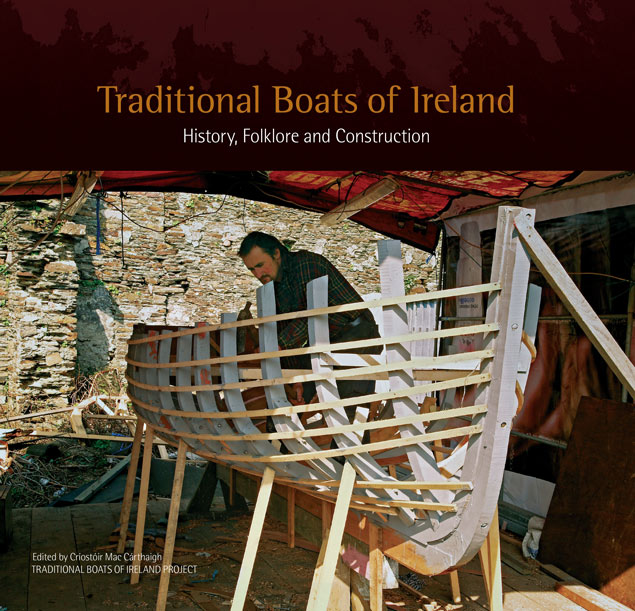 A major landmark in Irish maritime literature, the encyclopaedic Traditional Boats of Ireland was inspired by a Donal Lynch initiative
A major landmark in Irish maritime literature, the encyclopaedic Traditional Boats of Ireland was inspired by a Donal Lynch initiative
The Assistant Editor was Donal McPolin with Rionan ui Ogain, and the Technical Editors were Michael Tyrrell, Harry Madill, Cormac Levis, Paddy Barry, Hal Sisk and Donal Lynch. Not only had Donal Lynch been the prime mover in starting the project, but he had remained closely involved throughout, and for good measure had contributed three very readable and informative chapters on boat-building and traditional craft in his beloved West Cork.
When we remember that he was still working at full pressure as a partner in Horgan Lynch, it’s all the more remarkable that he was centrally involved in another project in the 1990s, the establishment with Padraig O Duinnin and others of Meitheal Mara in Cork city. It translates broadly as “Workers of the Sea”, and aspires to help those who otherwise might never have though of getting involved with boats and boatbuilding and the special experience of getting afloat. It describes itself as a “Community Boatyard”, but thanks to the input by people of the calibre of Donal Lynch, it is much more than that, as we gather from this tribute by the organisation’s manager Cathy Buchanan:
“Donal Lynch was involved in Meitheal Mara from its earliest days, and integral in many ways to the shape and development of the company. As a founding member of the Board in 1998, he understood the importance of good foundations, and took the lead in the important but dry work of drafting the Memorandum and Articles of Association.
Amongst many other things, he was instrumental in Meitheal Mara's purchase of the partially-built Bantry longboat Fionnbarra in 2007. He was a member of the crew that went with her the following summer to Canada to the international contest held to celebrate the 400th anniversary of the founding of Quebec. That crew spanned all ages, representing each decade from teens to 70s, and Donal filled the latter slot with flair and enthusiasm.
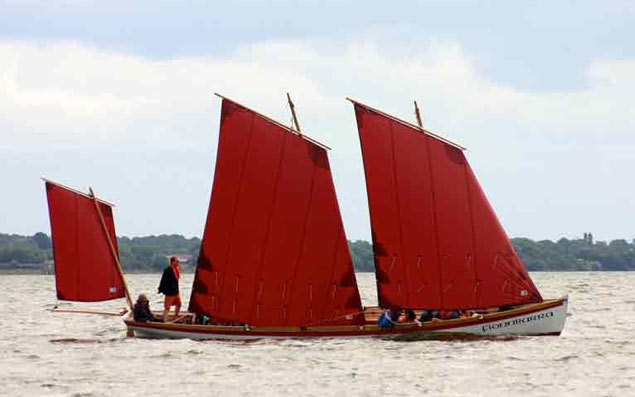 Meaitheal Mara’s Fionnbarra – Cork’s own Bantry Boat - making knots
Meaitheal Mara’s Fionnbarra – Cork’s own Bantry Boat - making knots
 The senior oarsman. Donal Lynch in the 70-years-plus rowing position aboard Fionnbarra in Quebec in 2008 at the Defi International Jeunes Marins for Bantry longboats, listening to crew member Wendie Young of Meitheal Mara. Photo: Cathy Buchanan
The senior oarsman. Donal Lynch in the 70-years-plus rowing position aboard Fionnbarra in Quebec in 2008 at the Defi International Jeunes Marins for Bantry longboats, listening to crew member Wendie Young of Meitheal Mara. Photo: Cathy Buchanan
Donal was a renaissance man with a love of the sea; an engineer and sportsman with a love of the arts. These latter two came together when Cork was designated European Capital of Culture in 2005, presenting a vehicle for Meitheal Mara to achieve Pádraig O Dúinnín’s idea of a long distance rowing race celebrating traditional boats and maritime culture. Donal was instrumental in making this idea of “An Rás Mór" real. His professionalism and extensive contacts were hugely influential in persuading the Cork 2005 team that Meitheal Mara could actually organise an event of this scale, and turn it into the success that it has become as the Ocean to City Race that is now a central component of the Cork Harbour Festival.
Donal saw the potential to promote Cork Harbour more widely as a centre for maritime recreation. He was central to the development of Meitheal Mara's position papers, New Destinations in Cork Harbour and A Slip for Cork. These led to a position paper on Cork Harbour itself, and Meitheal Mara's contribution as partner to the Cork Harbour Blueway Feasibility report in 2014. He has been integral to the thinking behind Meitheal Mara's commitment to developing a Maritime Activity Centre for Cork city and harbour.
His experience with Glandore Harbour Yacht Club's Classic Boat Regatta and Glandore Summer School on Irish maritime culture and traditions resulted in his development of Meitheal Mara's Lunchtime Lectures and the occasional series of Cork Harbour Summer Schools.
Donal is sorely missed for his inspirations, warm curiosity, his commitment and drive, and his ready availability and knowledge for advice on maritime matters.”
In that concluding paragraph, Cathy Buchanan speaks for us all. How Donal Lynch managed to achieve so many of his objectives without ever seeming to get unduly flustered, and while always retaining a genuine and kindly interest in others, was one of the wonders of the man – “he had his own personal sun shining on him”.
Thus even as he was involved with getting Meitheal Mara up and running, he found time to be fully supportive of Gary MacMahon, who at precisely the same time had brought the Ilen home from the Falkland Islands, and in 1998 was faced with the challenge of what best to do with this uniquely historic vessel.
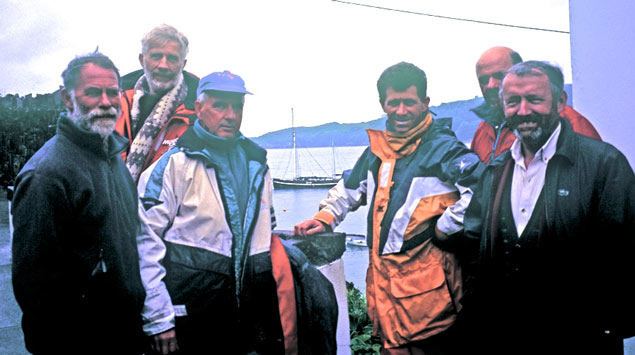 The Ilen finally reaches Glandore, May 1998. Photo includes (left to right) Paddy Barry, Padraig de Bhaldraith, Fionan de Barra, the Ilen, the late Pat Redmond, Martin O’Neill, and Donal Lynch
The Ilen finally reaches Glandore, May 1998. Photo includes (left to right) Paddy Barry, Padraig de Bhaldraith, Fionan de Barra, the Ilen, the late Pat Redmond, Martin O’Neill, and Donal Lynch
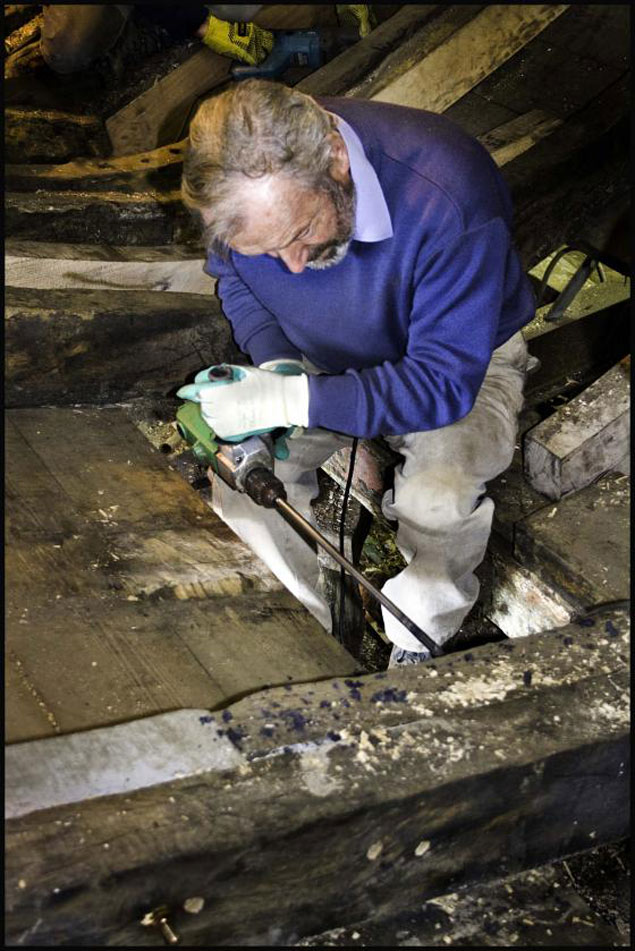 The restoration work on Ilen gets underway in 2008. In the bilges of the ship, Donal drills the old and new oak frames to accept bronze bolt fastenings. Photo: Kevin O’Farrell
The restoration work on Ilen gets underway in 2008. In the bilges of the ship, Donal drills the old and new oak frames to accept bronze bolt fastenings. Photo: Kevin O’Farrell
In fact, by the time the restoration work on Ilen was underway at Liam Hegarty’s boatyard in Oldcourt, Donal had retired and made himself available for work on the old ship. Yet he never forgot that ultimately boats should be all about sailing and particularly cruising (he’d been a member of the Irish Cruising Club since 1996), and he somehow - both when working and “retired” – carved out the time for cruising long distance with people like old friend Hugh Stevenson on his ocean-going catamarans Pelican and Laroha, their destinations including Svalbard to the north and the Falklands to the south, as well as a Transatlantic passage from Jamaica to Glandore and other voyages.
 Ocean voyager. Donal at the helm aboard Laroha on passage from Tenerife to the Cape Verdes
Ocean voyager. Donal at the helm aboard Laroha on passage from Tenerife to the Cape Verdes
Back in Ireland, the restoration by Michael Kennedy in Dunmore East of Hal Sisk’s 1894-built Watson 37ft cutter Peggy Bawn was another project close to Donal Lynch’s heart, and he was to sail on the Baltic and in America on the Peggy, while also making her welcome as Guest of Honour at the Glandore Classics. As ever when people like Hal Sisk and Donal Lynch get together, technological innovations come into the conversation, and they were both involved in encouraging Pat Tanner to develop his equipment for laser screening classic and traditional boats as the most effective way to take off their lines.
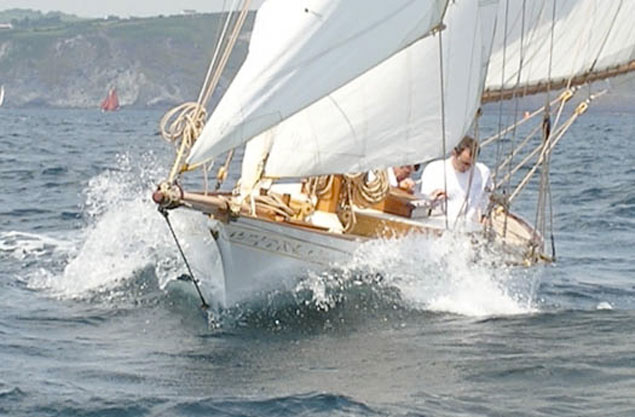 Hal Sisk’s superbly restored 1894 Watson cutter Peggy Bawn makes her debut at the Glandore Classics. Donal Lynch was to crew her in the Baltic and on the East Coast of America
Hal Sisk’s superbly restored 1894 Watson cutter Peggy Bawn makes her debut at the Glandore Classics. Donal Lynch was to crew her in the Baltic and on the East Coast of America
Donal always retained his interest in constructional engineering challenges, and as Frank Murray - one of his partners in Horgan Lynch - recalls: “In retirement, he continued to make himself available when advice was sought. The notebook would open, the pencil would sharpen, he would listen, pause, and then in a quiet voice dispense his words of wisdom as only he knew how”.
While it may have taken more than a dozen years for the Traditional Boats of Ireland book to come to fruition, once it was in being another publication flowed from it, the bi-lingual Glorious Galway: Hookers, Currachs, Lake and River-Boats Gaillimh na Seod, Gaillimh faoi Sheol (2011). Written by Donal Lynch, Padraic de Bhaldraithe, Catherine Buchanan and Donal MacPolin, it is 184 superb pages from the Copper Reed Studio, distributed through Meitheal Mara.
 Another fine addition to Irish maritime literature –Donal Lynch was lead author on the 2011-published Glorious Galway
Another fine addition to Irish maritime literature –Donal Lynch was lead author on the 2011-published Glorious Galway
And another Donal Lynch-inspired creation is Corkumnavigation, the fold-out guide to navigating around Cork city’s myriad of waterways in a small boat (2010; revised 2016) – in using it, you discover bits of Cork city and canoe and small boat cruising activities you never thought possible.
Yet while Cork city was a place of endless possibilities, he never forgot that the reason for setting up the Glandore Classic Boat Regatta and Summer School in the first place was ostensibly the raising of funds to provide Glandore Harbour YC with its own home, and on August 16th 2013, the new clubhouse - attractively-renovated two storey cottage at the harbour - was officially opened by Minister for the Marine Simon Coveney TD.
 Official opening by Minister for the Marine Simon Coveney TD of Glandore Harbour YC’s clubhouse, August 16th 2013. Donal Lynch fourth from right. Photo courtesy GHYC
Official opening by Minister for the Marine Simon Coveney TD of Glandore Harbour YC’s clubhouse, August 16th 2013. Donal Lynch fourth from right. Photo courtesy GHYC
By the time the revision of Corkumnavigation came out in 2016, Donal Lynch was a year away from his 80th birthday, yet he had found another interest which fitted in with his view of life. Perhaps he’d been told that a spot of cycling would be good exercise, but being Donal Lynch, he put an extra spin on it. He acquired a touring bike and set out to cycle the length of Europe’s great river valleys with his old friend Roddy Hogan.
They’d already been down the Rhone and the Danube, on expeditions planned with his quiet but infectious sense of enthusiasm. Other great rivers beckoned. But it was not to be. Our heartfelt condolences are with Donal Lynch’s family and his very many friends from near and far. The world is poorer for his loss, but he has left the world a much richer place.
The author would like to record his grateful thanks to the late Donal Lynch’s family and many friends and colleagues, who have contributed their thoughts, memories and photos so generously to this Appreciation.
Traditional Boatbuilding Leader Donal Lynch RIP
The death has occurred of Donal Lynch, one of Ireland’s leading figures in traditional boats, as Tom MacSweeney writes.
Donal was one of the founding and leading figures in the development of Meitheal Mara, the community and traditional boatyard in Cork city.
A stalwart member of Glandore Harbour Yacht Club in West Cork and a former club officer, he led the development of the Classic Boat Regatta there as well as the Glandore Summer School about the marine.
He had also been one of the main group in the publishing of the class Traditional Boats of Ireland book.
Donal’s solid, committed and dedicated involvement in the traditional boating scene will be very much missed. He was always a fount of wisdom, knowledge and sound advice on maritime matters.
Donal had been ill for some time and died at Marymount Hospice in Cork.
Among the many tributes being paid, Cathy Buchanan, Meitheal Mara manager, said Donal was “a great maritime man and much else besides. Meitheal Mara would be very different without his influence, if here at all.”


























